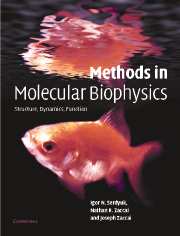Book contents
- Frontmatter
- Contents
- Foreword by D. M. Engelman
- Foreword by Pierre Joliot
- Preface
- Introduction: Molecular biophysics at the beginning of the twenty-first century: from ensemble measurements to single-molecule detection
- Part A Biological macromolecules and physical tools
- Part B Mass spectrometry
- Part C Thermodynamics
- Part D Hydrodynamics
- Chapter D1 Biological macromolecules as hydrodynamic particles
- Chapter D2 Fundamental theory
- Chapter D3 Macromolecular diffusion
- Chapter D4 Analytical ultracentrifugation
- Chapter D5 Electrophoresis
- Chapter D6 Electric birefringence
- Chapter D7 Flow birefringence
- Chapter D8 Fluorescence depolarisation
- Chapter D9 Viscosity
- Chapter D10 Dynamic light scattering
- Chapter D11 Fluorescence correlation spectroscopy
- Part E Optical spectroscopy
- Part F Optical microscopy
- Part G X-ray and neutron diffraction
- Part H Electron diffraction
- Part I Molecular dynamics
- Part J Nuclear magnetic resonance
- References
- Index of eminent scientists
- Subject Index
- References
Chapter D11 - Fluorescence correlation spectroscopy
from Part D - Hydrodynamics
Published online by Cambridge University Press: 05 November 2012
- Frontmatter
- Contents
- Foreword by D. M. Engelman
- Foreword by Pierre Joliot
- Preface
- Introduction: Molecular biophysics at the beginning of the twenty-first century: from ensemble measurements to single-molecule detection
- Part A Biological macromolecules and physical tools
- Part B Mass spectrometry
- Part C Thermodynamics
- Part D Hydrodynamics
- Chapter D1 Biological macromolecules as hydrodynamic particles
- Chapter D2 Fundamental theory
- Chapter D3 Macromolecular diffusion
- Chapter D4 Analytical ultracentrifugation
- Chapter D5 Electrophoresis
- Chapter D6 Electric birefringence
- Chapter D7 Flow birefringence
- Chapter D8 Fluorescence depolarisation
- Chapter D9 Viscosity
- Chapter D10 Dynamic light scattering
- Chapter D11 Fluorescence correlation spectroscopy
- Part E Optical spectroscopy
- Part F Optical microscopy
- Part G X-ray and neutron diffraction
- Part H Electron diffraction
- Part I Molecular dynamics
- Part J Nuclear magnetic resonance
- References
- Index of eminent scientists
- Subject Index
- References
Summary
Historical review
1916
M. von Smoluchowski gave the first theoretical description of the amplitude and the temporal decay of number fluctuations in a diffusion system.
1972–1974
D. Magde, E. L. Elson and W. W. Webb published a rigorous formalism of fluorescence correlation spectroscopy (FCS) with its various modes of possible application, highlighting the large potential of this variant of the relaxation method.
1990
R. Rigler and coworkers made the final breakthrough for the FCS method. They reached the single-molecule detection limit by combining FCS with a confocal set-up, thus increasing the signal-to-noise ratio dramatically. By tightly focusing a laser beam and inserting a pinhole into the image plane, maximum lateral and axial resolution were achieved.
1994
M. Eigen and R. Rigler triggered an important further development by proposing the application of dual-colour cross-correlation for diagnostic purposes. The underlying idea was to separate single-labelled reaction educts from dual-labelled reaction products to discriminate against an excess of free single-labelled species and thus enhance the specificity of detection. In 1997 P. Schwille and coworkers successfully monitored a hybridisation reaction of two differently labelled oligonucleotides by the dual-colour cross-correlation technique. In 2000 K. G. Heinze and coworkers, reported the application of dual-colour two-photon cross-correlation to determine enzymatic cleavage of a DNA substrate by endonuclease.
2000 to now
FCS has evolved into a whole family of related methods sharing the basic principle of fluorescence fluctuation analysis.
Information
- Type
- Chapter
- Information
- Methods in Molecular BiophysicsStructure, Dynamics, Function, pp. 505 - 516Publisher: Cambridge University PressPrint publication year: 2007
